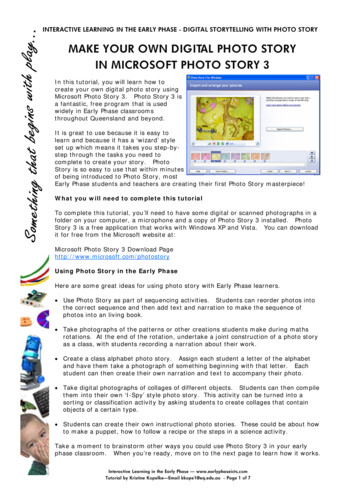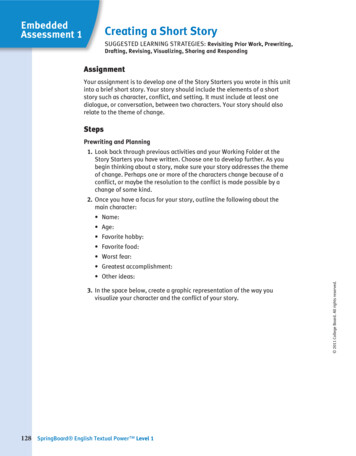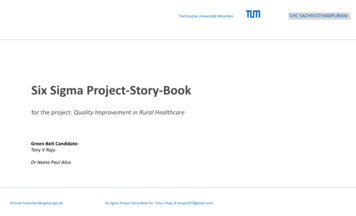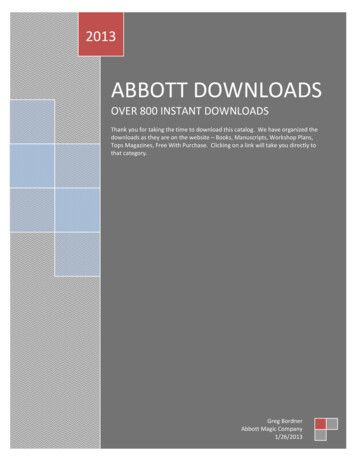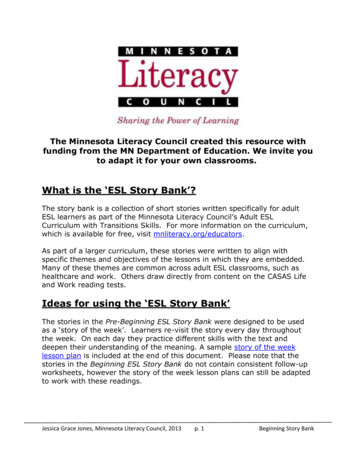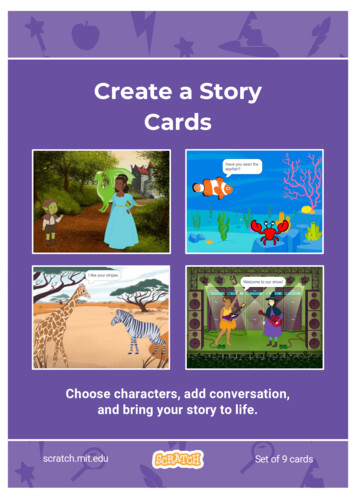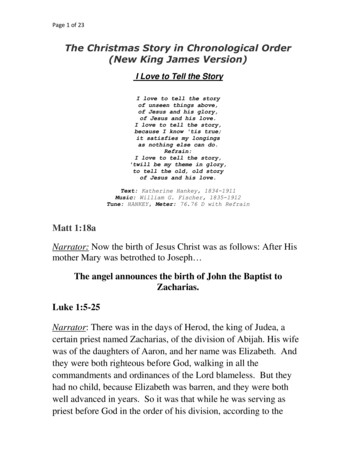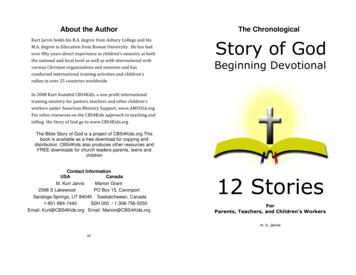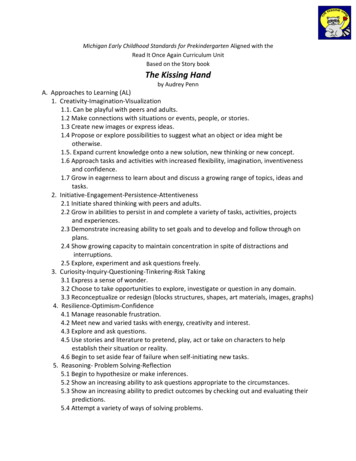
Transcription
Michigan Early Childhood Standards for Prekindergarten Aligned with theRead It Once Again Curriculum UnitBased on the Story bookThe Kissing Handby Audrey PennA. Approaches to Learning (AL)1. Creativity-Imagination-Visualization1.1. Can be playful with peers and adults.1.2 Make connections with situations or events, people, or stories.1.3 Create new images or express ideas.1.4 Propose or explore possibilities to suggest what an object or idea might beotherwise.1.5. Expand current knowledge onto a new solution, new thinking or new concept.1.6 Approach tasks and activities with increased flexibility, imagination, inventivenessand confidence.1.7 Grow in eagerness to learn about and discuss a growing range of topics, ideas andtasks.2. Initiative-Engagement-Persistence-Attentiveness2.1 Initiate shared thinking with peers and adults.2.2 Grow in abilities to persist in and complete a variety of tasks, activities, projectsand experiences.2.3 Demonstrate increasing ability to set goals and to develop and follow through onplans.2.4 Show growing capacity to maintain concentration in spite of distractions andinterruptions.2.5 Explore, experiment and ask questions freely.3. Curiosity-Inquiry-Questioning-Tinkering-Risk Taking3.1 Express a sense of wonder.3.2 Choose to take opportunities to explore, investigate or question in any domain.3.3 Reconceptualize or redesign (blocks structures, shapes, art materials, images, graphs)4. Resilience-Optimism-Confidence4.1 Manage reasonable frustration.4.2 Meet new and varied tasks with energy, creativity and interest.4.3 Explore and ask questions.4.5 Use stories and literature to pretend, play, act or take on characters to helpestablish their situation or reality.4.6 Begin to set aside fear of failure when self-initiating new tasks.5. Reasoning- Problem Solving-Reflection5.1 Begin to hypothesize or make inferences.5.2 Show an increasing ability to ask questions appropriate to the circumstances.5.3 Show an increasing ability to predict outcomes by checking out and evaluating theirpredictions.5.4 Attempt a variety of ways of solving problems.
5.5 Demonstrate enjoyment in solving problems.5.6 Gather information and learn new concepts through experiences and discovery,making connections to what they already know.5.7 Share through words or actions the acquisition of increasingly complex concepts.5.8 Show an increasing ability to observe detail and attributes of objects, activitiesand processes.6. tion6.1 Learn from and through relationships and interactions.6.2 Show and increasing ability to initiate and sustain age-appropriate play and interactions with peers and adults.6.3 Begin to develop and practice the use of problem-solving and conflict resolutionskills.6.4 Recognize respectfully the similarities and differences in people (gender, family,race, culture, language).6.5 Show an increasing capacity to consider or take into account another’s perspective.6.6 Can join a community of learners in person and digitally as appropriate; enjoymutual engagement.6.7 Contribute individual strengths, imagination or interests to a group.6.8 Successfully develop and keep friendships.6.9 Participate successfully as group members.6.10 Demonstrate an increasing sense of belonging and awareness of their roles asmembers of families, classrooms and communities.7. Respect for Self and Others-Mental and Behavioral Health7.1 Show increasing respect for the rights of others.7.2 Extend offers of help to peers or adults to help them feel that they belong to thegroup.7.3 Cope with stress in a reasonable and age appropriate way. Grow in their capacity toavoid harming themselves, others, or thing around them when expressing feelings,needs and opinions.7.4 Use positive communication and behaviors (do not mock, belittle or exclude others).7.5 Resolve or attempt to resolve conflicts respectfully.7.6 Increasingly develop greater self-awareness; identify their own interests andinterests and strengths. Can be comfortable choosing to be alone.7.7 Demonstrate the ability to care. Can respond with sensitivity or sincerity, laterempathy.7.8 Can resist and effectively respond to inappropriate peer pressure (age appropriate).7.9 Demonstrate positive feelings about their own gender, family, race, culture orlanguage.7.10 Exhibit a growing capacity to self-regulate, demonstrate self-efficacy and knowacceptable boundaries.7.11 Demonstrate a reasonable self-perception of confidence, can make choicesand explain discoveries.
8. Responsibility-Ethical Actions8.1 Contribute to the community as age appropriate.8.2 Grow in understanding of the need for rules and boundaries in their learningand social environments.8.3 Show an increasing ability to follow simple, clear and consistent directions and rules.8.4 Begin to take action to fix their mistakes, solve problems with materials andresolve conflicts with others; do not blame others inappropriately.8.5 Take initiative to do something positive to contribute to their community as ageappropriate.8.6 Increase understanding of the relationship between people and their environmentand begin to recognize the importance of taking care of the resources in theenvironment.8.7 Use materials purposefully, safely and respectfully more of the time.8.8 Respect the property of others and that of the community.B. Creative Arts (CA)1. Visual Arts1.1 Use their own ideas to draw, paint, mold and build with a variety of are materials.1.2 Begin to plan and carry out projects and activities with increasing persistence.1.3 Begin to show growing awareness and use of artistic elements (line, shape, color,form).1.4 Create representations that contain increasing detail.2. Instrumental and Vocal Music2.1 Participate in musical activities (listening, singing, finger plays, games and simpleperformances) with others.2.2 Begin to understand that music comes in a variety of musical styles.2.3 Begin to understand and demonstrate the components of music (tone, pitch, beat,rhythm, melody).2.4 Become more familiar with and experiment with a variety of musical instruments.3. Movement and Dance3.1 Can respond to selected varieties of music, literature or vocal tones to expresstheir feelings and ideas through creative movement.3.2 Begin to show awareness of contrast through use of dace elements (time, space,energy).3.3 Begin to identify and create movement in place and through space.4. Dramatic Play4.1 Grow in the ability to pretend and to use objects as symbols for other things.4.2 Use dramatic play to represent concepts, understand adult roles, characters, andfeelings.4.3 Begin to understand components of dramatic play (setting, prop, costume, voice).4.4 Contribute ideas and offer suggestions to build the dramatic play theme.4.5 Begin to differentiate between fantasy and reality.
5. Aesthetic Appreciation5.1 Develop healthy self-concepts through creative arts experiences.5.2 Show eagerness and pleasure when approaching learning through the creative arts.5.3 Show growing satisfaction with their own creative work and growing respect for thecreative work of others.5.4 Can use alternative forms of art to express themselves depending on the avenuesavailable to them.5.5 Are comfortable sharing their ideas and work with others.5.6 Use the creative arts to express their view of the world.5.7 Begin to develop their own preferences for stories, poems, illustrations, forms ofmusic, and other works of art.5.8 Begin to appreciate their artistic heritage and that of other cultures.5.9 Can talk about their creations with peers and adults.5.10 Begin to develop creative arts vocabulary.C. Language and Early Literacy Development (LL)1. Emergent Reading-Comprehension (A)1.A.1 Enlarge their vocabularies both with words from conversation and instructionalmaterials and activities.1.A.2 Use different strategies for understanding written materials (making predictionsusing what they already know, using the structure of texts, linking themselves andtheir experiences to the written materials, asking relevant questions).1.A.3 Demonstrate reading-like behaviors with familiar written materials.1.A.4 Talk about preferences for favorite authors, kinds of books and topics and questionthe content and author’s choices (critical literacy).Emergent Reading – Print and Alphabet Knowledge (B)1.B.1 Show progress in identifying and associating letters with their names and sounds.1.B.2 Recognize a few personally meaningful words including their own name, “mom,”“dad,” signs and other print in their environment.1.B.3 Participate in play activities with sounds (rhyming games, finger plays).Emergent Reading-Concepts about Reading (C)1.C.1 Understand that ideas can be written and then read by others.1.C.2 Understand print and book handling concepts including directionality, title, etc.1.C.3 Understand that people read for many purposes (enjoyment, information,to understand directions).1.C.4 Understand that printed materials have various forms and functions (signs, labels,letters, types).1.C.5 Develop an understanding of the roles of authors and illustrators.
2. Writing Skills2.1 Begin to understand that their ideas can be written and then read by themselves or others.2.2 Use a variety of form of early writing (scribbling, drawing, use of letter strings,copied environment print) and move toward the beginning of phonemic andconventional spelling.2.3 Begin to develop an understanding of purposes for writing (lists, directions, stories,invitations, labels).2.4 Represent their own or imaginary experiences through writing.2.5 Begin to write familiar words such as their own name.2.6 Attempt to read or pretend to read what they have written to friends, familymembers and others.2.7 Show beginnings of a sense of the need to look over and modify their writings anddrawings.2.8 Develop greater control over the physical skills needed to write letters and numbers.3. Spoken Language: Expressive3.1 Use spoken language for a variety of purposes (express feelings, ask questions, talkabout experiences, ask for help, respond to others).3.2 Show increasing comfort and confidence when speaking.3.3 Experiment and play with sounds (rhyming, alliteration, playing with sounds, andother aspects of phonological awareness).3.4 Continue to develop vocabulary by using words learned from stories and othersources in conversations.3.5 Speak in increasingly more complex combinations of words and in sentences.3.6 Understand the roles of the participants in conversation (taking turns inconversation and relating their own comments to what is being talked about; askingquestions).3.7 Take part in different kinds of roles as a speaker (part of a group discussion, roleplaying, fantasy play, storytelling, and retelling).3.8 Use nonverbal expressions and gestures to match and reinforce spoken expression.3.9 Show progress in speaking both their home language and English.3.10 If appropriate, show progress in learning alternative communication strategies suchas sign language.4. Spoken Language: Receptive4.1 Gain information from listening (conversations, stories, songs, poems).4.2 Show progress in listening to and following spoken directions.4.3 Show progress in listening attentively, avoiding interrupting others, learning to berespectful.4.4 Respond with understanding to speech directed at them.4.5 Understand the concept and role of an audience (being part of the audience,being quiet, being considerate, looking at the speaker).
4.6 Understand and respond appropriately to non-verbal expressions and gestures.4.7 Show progress in listening to and understanding both their home language andEnglish.5. Viewing Images and Other Media5.1 View images and other media materials for a variety of purpose (gain informationfor pleasure, to add to their understanding of written materials, for visual cues orcreative purposes.5.2 Use different strategies for understanding various media (making predictions usingwhat already know, using the structure of the image or media, linking themselvesand their experiences to the content, asking relevant questions).5.3 Begin to compare information across sources and discriminate between fantasy andfiction.6. Positive Attitudes about Literacy6.1 Choose to read, write, listen, speak and view for enjoyment and information, and toexpand their curiosity.6.2 Demonstrate emotion from literacy experiences (laughter, concern, curiosity).6.3 Make connections with situations or events, people or stories.6.4 Approach tasks and activities with increased flexibility, imagination, inventiveness,and confidence.6.5 Show growth in eagerness to learn about and discuss a growing range of topics,ideas and tasks.7. Diversity of Communication7.1 Understand that some people communicate in different languages and other formsof English.7.2 Become aware of the value of the language used in their homes.7.3 Become aware of alternate and various forms of communication (Braille, signlanguage, lip reading, digital communication tablets).7.4 Begin to understand the value and enjoyment of being able to communicate inmore than one language or form of communication.D. Dual Language Learning (DLL)1. Receptive English Language Skills1.1 Observe peers and adults with increasing attention to understand language andintent.1.2 Respond with non-verbal actions and basic English words or phrases tocommunicate.1.3 Demonstrate increased understanding of simple words and phrases used in dailyroutines or content studies.1.4 Increase understanding of multiple meanings of words.1.5 Exhibit a growing vocabulary of basic and high-frequency words.1.6 Demonstrate a beginning of phonological awareness and phonics.
2. Expressive English Language Skills2.1 Express basic needs using common words or phrases in English.2.2 Participate with peers and adults in simple exchanges in English.2.3 As age appropriate, attempt to use longer sentences or phrases in English.2.4 Continue to use and build home language as needed to build understanding ofwords and concepts in second language.3. Engagement in English Literacy Activities3.1 Demonstrate increasing attention to stories and book reading.3.2 Name or recall characters in stories.3.3 Use both verbal and nonverbal methods to demonstrate understanding as earlyliteracy skills increase.3.4 Begin to talk about books, stories, make predictions or take a guess about the book.4. Engagement in Writing4.1 Engage in early drawing or emergent writing attempts.4.2 Copy letters of the English alphabet as age appropriate.4.3 Write or copy important words (family, name, friends).4.4 Write name and using a capital letter at the beginning.4.5 Copy words or labels from integrated learning (math, science, arts) experiences.4.6 Use drawing and emergent writing together.5. Social Interaction5.1 Demonstrate and also accept positive verbal and non-verbal interactions from peers.5.2 Engage with the teacher and others in a positive manner.5.3 Communicate emotions appropriately; beginning to label feelings.5.4 Show both verbal and non-verbal attempts to participate with peers.5.5 Write, draw and talk about family and cultural traditions.5.6 Demonstrate pride and recognition of first language.5.7 Build skills in first language.E. Technology Literacy-Early Leaning and Technology (TL)1. Creativity and Innovation1.1 Can describe and creatively use a variety of technological tools independently or withpeer or adult help.1.2 Understand that technology tools can be used throughout the day.1.3 Understand that different technology tools have different uses, includingcommunicating feelings and ideas.2. Communication and Collaboration2.1 Respond to other children’s technology products vocally or within the tech. tool.3. Research and Information Literacy3.1 Begin to be able to navigate developmentally appropriate websites.3.2 Understand that the internet can be used to locate information as well as forentertainment.3.4 Respond to information found on the internet in developmentally appropriate ways.
4. Critical Thinking, Problem Solving and Decision Making4.1 Talk, ask questions, solve problems and share ideas with peers and adults, whenusing computers and other technology tools.4.2 When faced with a problem, suggest the use of technology tool to solve the problem.5. Digital Citizenship5.1 Begin to state and follow rules for safe use of the computer and other technologytools.5.2 Begin to understand how technology can be used inappropriately.5.3 Identify the Michigan Cyber Safety Initiative’s three rules (Keep Safe, Keep Away,Keep Telling).5.4 Identify personal information that should not be shared on the Internet or phone(name, address, phone number).5.5 Know to use the computer only when an adult is supervising and to inform atrusted adult if anything on the Internet creates discomfort.6. Technology Operations and Concepts6.1 Can follow simple directions to use common technology tools.6.2 Recognize and name the major parts of a computer and other devices.6.3 Understand the need for and demonstrate basic care for technology equipment.6.4 Use adaptive devices to operate a software program as necessary.F. Social, Emotional and Physical Health and Development (SEP)1. Understanding of Self1.1 Show emerging sense of self-awareness.1.2 Continue to develop personal preferences.1.3 Demonstrate growing confidence in expressing their feelings, needs and opinions.1.4 Become increasingly more independent.1.5 Recognize and have positive feelings about their own gender, family, race, cultureand language.1.6 Identify a variety of feelings and moods (in themselves and others).2. Expressing Emotions2.1 Grow in their capacity to avoid harming themselves, others, or things around themwhen expressing feelings, needs and opinions.2.2 Grow in their ability to follow simple, clear and consistent directions and rules.2.3 Use materials purposefully, safely, and respectfully more and more of the time.2.4 Begin to know when and how to seek help from an adult or peer.2.5 Manage transitions and follow routines moist of the time.2.6 Can adapt to different environments.3. Relationships with Others3.1 Increase their ability to initiate and sustain age-appropriate interactions with peersand adults.
4.5.6.7.3.2 Begin to develop and practice the use of problem-solving and conflict resolutionskills.3.3 Recognize similarities and differences in people (gender, race, culture, language).3.4 Increase their capacity to take another’s perspective.3.5 Show increasing respect for the rights of other.3.6 Show progress in developing and keeping friendships.3.7 Participate successfully as a group member.3.8 Demonstrate an increasing sense of belonging and awareness of their role as amember of a family, classroom and community.Body Control and Activity4.1 Begin to recognize and learn the names of body parts.4.2 Begin to understand spatial awareness for themselves, others and theirenvironment.4.3 Participate actively and on a regular basis, in games, outdoor play, and other formsof vigorous exercise that enhance physical fitness.4.4 Increasingly develops greater self-awareness; identifies his or her own interest andstrengths.Gross Motor Development5.1 Begin or continue to develop traveling movements such as walking, climbing,running, jumping, hopping, skipping, marching, and galloping.5.2 Show their ability to use different body parts in a rhythmic pattern.5.3 Show increasing abilities to coordinate movements (throwing, catching, kicking,bouncing balls, using the slide and swing) in order to build strength, flexibility,balance, and stamina.5.4 Exhibit a growing capacity to self-regulate, demonstrate self-efficacy and knowacceptable boundaries (riding a tricycle of bike, using their bodies in helpful vs.hurtful ways, being a ‘leader’ in a game).Fine Motor Development6.1 Develop and refine motor control and coordination, eye-hand coordination,finger/thumb and whole-hand strength coordination and endurance using a varietyof age appropriate tools (scissors, pencil, markers, crayons, blocks, puzzles).6.2 Use fine motor skills they are learning in daily activities (dressing themselves).Positive Activity7.1 Learn to cooperate with others through games and other activities and actionsthat show a growing knowledge of the rights of others.7.2 Take pride in their own abilities and increase self-motivation.7.3 Begin to develop an appreciation and respect for the varying physical abilities andcapabilities of others.7.4 Demonstrate increasing ability to be together with others, in play or intellectuallearning opportunities and /or making positive efforts for the good of all.
8. Healthy Eating8.1 Grow in their understanding of the importance of eating nutritious meals andsnacks at regular intervals, and how this relates to good health.8.2 Begin to listen to body signals of hunger and fullness, learn to choose how muchto eat at meals and snacks and are able to convey their needs for food to adults.8.3 Use age/developmentally appropriate eating utensils safely and correctly.8.4 Become aware of foods that cause allergic reactions for some children and/orother dietary restrictions.9. Healthy Choices9.1 Show growing independence in keeping themselves clean, personal care wheneating, dressing, washing hands, brushing teeth, use of tissues for nose-blowingand toileting.9.2 Grow in understanding of the importance of good health and its relationship tophysical activity.9.3 Talk about ways to prevent spreading germs and diseases to other people.9.4 Develop an understanding of basic oral hygiene.9.5 Begin to be able to recognize activities that contribute to the spread of diseases(sharing of cups, eating utensils, hats, clothing, foods).9.6 Can begin to recognize some symptoms of disease or health issues (sore thoat)and common instruments used in diagnosing disease (thermometer).9.7 Begin to become aware of activities, substances and situations that may posepotential hazards to health (smoking, poisonous material plants, berries,medications).10. Personal Safety10.1 Begin to learn appropriate safety procedures (in the home, at school, as apedestrian, outdoors, on the playground, with cars, with bikes, around water).10.2 Identify persons who they can turn to in an emergency situation.10.3 Begin to know important facts about themselves (address, phone number,parents’ names.10.4 Become aware of issues relative to personal safety (inappropriate touching,good and bad secrets, learning how to say no to inappropriate touching byany other person, recognizing when to tell an adult about an uncomfortablesituation.10.5 Begin to lean the correct procedure for self-protection in emergency situations(tornados, fire storms, gun fire, chemical spills, avoidance of other’s blood andvomit).10.6 Begin to try new activities with just manageable risk (riding a tricycle, climbingsafely, jumping, exploring).10.7 Exhibit a growing capacity to self-regulate, demonstrate self-efficacy and knowacceptable boundaries.
G. Early Learning in Mathematics (M)1. Math Practice1.1 Try to solve problems in their daily lives using mathematics (how may napkinsare needed).1.2 Generate new problems from every day mathematical situations and use currentknowledge and experience to solve them (distribute crackers).1.3 Begin to develop and use various approaches to problem solving based upon theirtrial and error experience.1.4 Begin to talk about the processes and procedures they used to solve concrete andsimple mathematical situations.1.5 Begin to generate problems that involve prediction, collection and analyzinginformation and using simple estimation.2. Mathematical Literacy2.1 Participate regularly in informal conversations about mathematical concepts andnumber relationships.2.2 Begin to record their work with numbers in a variety of simple concrete and pictorialformats, moving toward some use of number and other mathematical symbols.2.3 Begin to use symbols to represent real objects and quantities.2.4 Make progress from matching and recognizing number symbols to reading andwriting numbers.2.5 Talk about their own mathematical explorations and discoveries using simplemathematical language and quantity related words.2.6 Begin to recognize that information comes in many forms and can be organizedand displayed in different ways.2.7 Begin to describe comparative relationships (more/less/same number of objects).3. Classification and Patterns3.1 Recognizing, describe, copy, extend, and create simple patterns with real objectsand through pictures.3.2 Identify patterns in their environment.3.3 Investigate patterns and describe relationships.3.4 Recognize patterns in various formats ( things that can be seen, heard or felt).4. Counting and Cardinality4.1 Develop an increasing interest and awareness of numbers and counting as a meansfor determining quantity and solving problems.4.2 Match, build, compare and label amounts of objects and events in their dailylives.4.3 Make progress in moving beyond rote counting to an understanding of conceptualcounting (one-to-one correspondence).
4.4 Recognize and match number symbols for small amounts with the appropriateamounts (subitizing).4.5 Show progress in linking number concepts, vocabulary, quantities and writtennumerals in meaningful ways.4.6 Show growth in understanding that number words and numerals representquantities.4.7 Use cardinal and ordinal numbers in daily home and classroom life.4.8 Understand how numbers can be used to label various aspects of their lives(house number, phone number, age).4.9 Develop an increasing ability to count in sequence up to ten and beyond.5. Simple Operations and Beginning Algebraic Thinking5.1 Begin to develop the ability to solve problems involving joining, separating,combining and comparing amounts when using small quantities of concretematerials.5.2 Can generate problems that involve prediction, collection, and analyzinginformation.5.3 Use simple estimation to make better guesses.5.4 Identify likenesses and difference.5.5 Can place objects or events in order, according to a given criterion (color, size, shape,time).5.6 Recognize that the same group can be sorted and classified in more than one wayand describe why they would group or sequence in a particular way.5.7 Begin to understand that simple concrete and representational graphs are ways ofcollecting, organizing, recording, and describing information.6. Measuring6.1 Show awareness that things in their environment can be measured.6.2 Begin to understand concepts of weight.6.3 Show an awareness of the concept of time, beginning with the recognition of timeas a sequence of events and how time plays a role in their daily lives (breakfast,lunch, dinner).6.4 Show an awareness of temperature as it affects their daily lives.6.5 Use beginning skills of estimation in solving everyday measurement problems(about how many cookies are need for a small group of children).6.6 Begin to use nonstandard measurements (length of hand) for length and area ofobjects.6.7 Begin to understand that tools (rulers, scales, counters) can be used to measureproperties of objects and amounts.
7. Geometry7.1 Can make models, draw, name and classify common shapes and verballydescribe them in simple terms.7.2 Investigate and begin to predict the results of combining, subdividing, andchanging shapes.7.3 Begin to recognize and appreciate geometric shapes In their environment.7.4 Begin to build an understanding of directionality, order and positions of objectsthrough the use of words (up, down, over, under, top). Identify patterns inenvironment.7.5 Recognize, describe, copy, extend and create simple patterns with real objectsand through pictures.7.6 Investigate patterns and describe relationships.7.7 Recognize patterns in various formats (seen, felt, heard).H. Early Learning in Science (S)1. Observation and Inquiry1.1 Demonstrate curiosity about and interest in their natural environment that leadsthem to confidently engage in activities related to science.1.2 Ask questions related to their own interests and observations.1.3 Talk about their own predictions, explanations and generalizations base on pastand current experiences.1.4 Expand their observational skills (extending the time they observe, being able todescribe and confirm their observations by using a variety of resources).1.5 Begin to participate in simple investigations (asking questions, manipulatingmaterials, anticipating what might happen next, testing their observations).2. Living and Non-living Things2.1 Demonstrate a growing ability to collect, talk about and record information aboutliving and non-living things (discussions, drawings).2.2 Begin to categorize living and non-living things in their environment based oncharacteristics they can observe (texture, color, size, shape, temperature, weight).2.3 Use observation skills to build awareness of plants and animals, their life cycles,(birth, aging, death) and basic needs (food, water, light, rest).2.4 Begin to describe relationships among familiar plants and animals (caterpillarseat leaves).2.5 Begin to describe the places in which familiar plants and animals in theirneighborhoods live (city, pond, parks, fields, forests).2.6 Demonstrate a greater knowledge and respect for their bodies (describe visible partsof the human body and their functions).2.7 Observe, describe and compare the motions of common objects in terms of speedand direction (faster, slowest, up, down).
3. Knowledge about the Earth3.1 Can talk about observable characteristics of different seasons.3.2 Can talk about the observable properties of earth materials (sand, rocks, soil,water) and living organisms.3.3 Can talk about major features of the earth’s surface (streams, hills, beaches) whenfound in the children’s neighborhood and neighborhood they visit.3.4 Begin to describe weather and its changing conditions (wind, rain, snow, clouds).3.5 Talk about ways to be safe during bad weather and in outdoor e
1.C.2 Understand print and book handling concepts including directionality, title, etc. 1.C.3 Understand that people read for many purposes (enjoyment, information, to understand directions). 1.C.4 Understand that printed materials have various forms and functions (signs, labels, letters, types).



